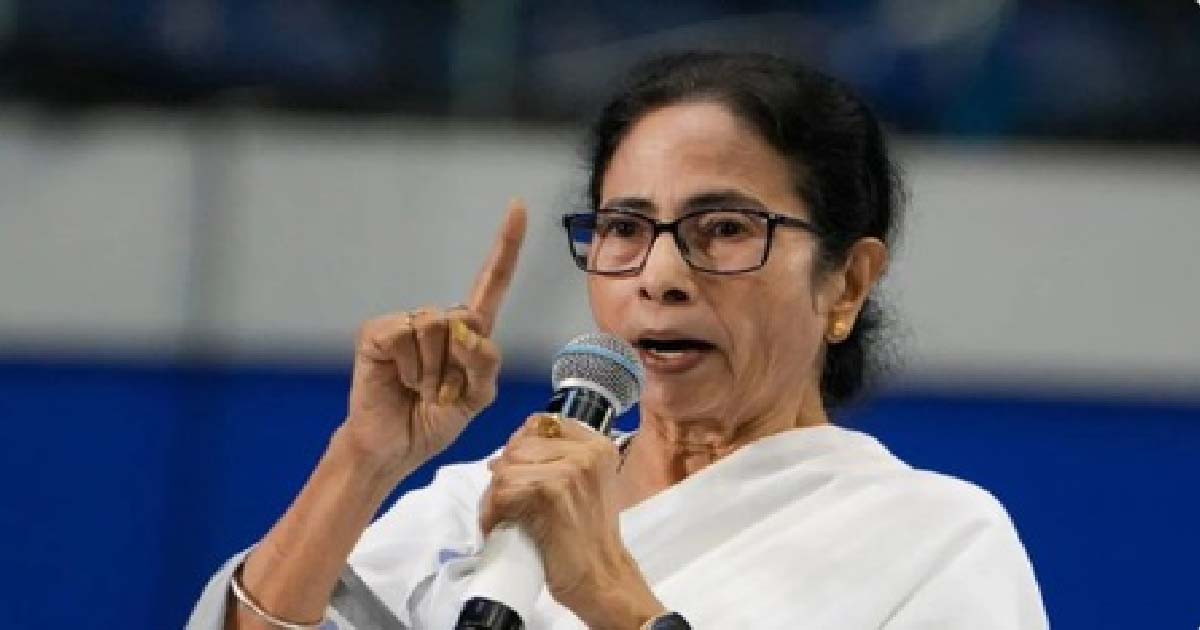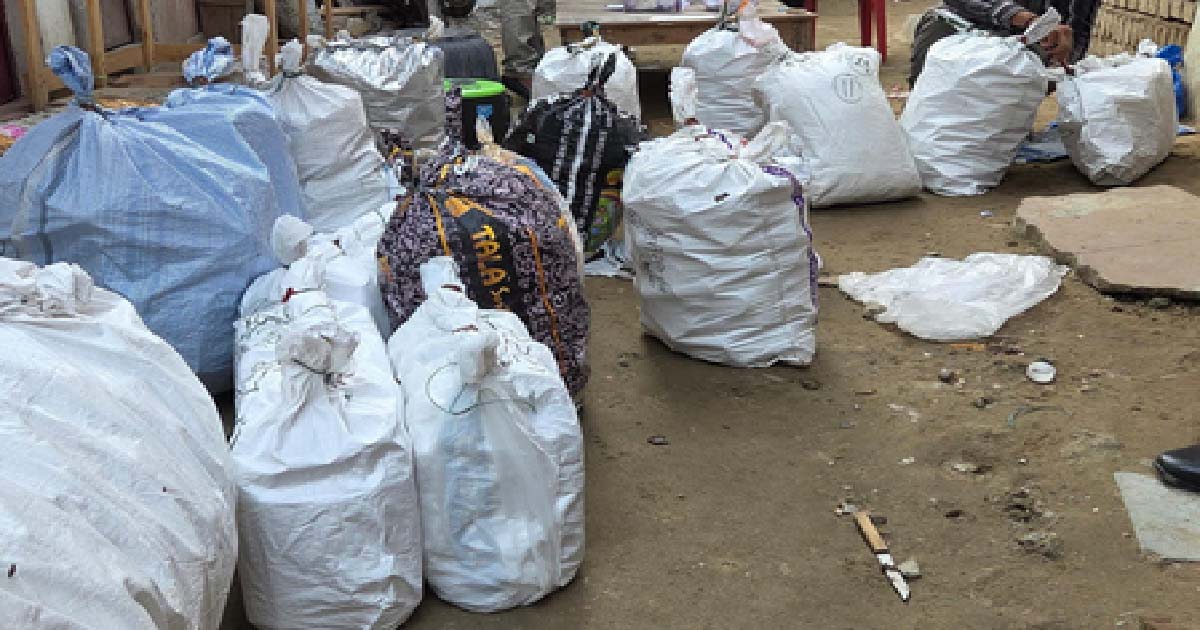National News
Mamata Banerjee to hold meeting with Bengal imams next week on opposing Waqf Act

Kolkata, April 11: West Bengal Chief Minister Mamata Banerjee will hold a meeting with the imams, muezzins, and religious leaders from the Muslim community in the state on April 16 to prepare the blueprint on how to oppose the recently promulgated Waqf Amendment Act.
The venue of the meeting will be Netaji Indoor Stadium in central Kolkata.
Firhad Hakim, the West Bengal Municipal Affairs and Urban Development Minister and the Mayor of Kolkata Municipal Corporation, will also be present at the meeting.
Recently, at a programme of the Jain community in Kolkata, the Chief Minister gave a subtle message to the Union government that the Waqf Amendment Act will not be implemented in West Bengal.
He also described the Waqf Act as an “attempt to snatch others’ property”.
“Just as no one has the right to snatch my property, similarly, I too do not have the right to snatch others’ property. In West Bengal, I will never allow that. In West Bengal, the people from the minority community are almost 33 per cent of the population. Always remember that your Didi is there to protect you and your property. Our mission should be — ‘Jio Aur Jine Do (Live and let live)’,” CM Banerjee said on Wednesday.
Political observers feel that the proposed meeting at Netaji Indoor Stadium on April 16 will be an extension of the Chief Minister’s proclamation as regards the Act and the involvement of the imams, muezzins, and religious leaders from the Muslim community had been done to ensure that future movements on this issue take a bigger shape in the coming days.
Haikm, on Friday, told media persons that West Bengal is fortunate to have a Chief Minister as a result of which the interests of people from all religious communities are protected in the state.
“In West Bengal, there is no question of misrule arising out of attempts to divide people on the basis of religious beliefs. Our protests against the Waqf Amendment Act will continue,” he said.
Crime
Mumbai Shocker: Retired Army Man Arrested For Sexually Assaulting Minor Girl In Chembur

Mumbai: Mumbai Police have registered a case under the stringent Protection of Children from Sexual Offences (POCSO) Act against a 59-year-old retired Army personnel following the alleged sexual assault of a 15-year-old girl.
The horrifying incident came to light unexpectedly over the weekend. According to the police, the minor survivor was rushed to Sion Hospital after complaining of acute and persistent abdominal pain. During the medical examination, doctors delivered a shocking diagnosis to the girl’s mother that the minor was approximately two months pregnant.
This immediate and grave revelation led the mother, a 37-year-old housekeeping professional residing in Chembur, to question her daughter. Under threats and suffering, the teenage girl disclosed a distressing tale of abuse, identifying the perpetrator as a retired Army ‘uncle’ who lived in the same residential building.
The victim revealed that the accused had molested and forcibly assaulted her on multiple occasions between September 1 and October 6, 2025, while threatening her to maintain silence. Out of fear and intimidation, the young girl had kept the abuse hidden until the worsening physical pain forced her to confide in her parent. Following the confirmation of the pregnancy, the distressed mother immediately approached the RCF Police Station and filed a formal complaint detailing the sexual assault and abuse.
Acting swiftly, the RCF Police immediately registered a First Information Report (FIR) under relevant sections of the Indian Penal Code and the provisions of the POCSO Act, given the survivor’s minority status. Cops confirmed that the accused, who resided in the same building as the victim’s family, was swiftly taken into custody.
The retired serviceman was produced before a special POCSO court, which remanded him to police custody for further custodial interrogation. Authorities have confirmed that preliminary medical and forensic examinations are being conducted on both the survivor and the accused as part of the ongoing, sensitive probe.
Crime
Rs one crore oxytocin smuggling racket busted in Lucknow, two arrested

Lucknow, Nov 10: The Special Task Force (STF) has busted a large-scale racket involved in the illegal manufacturing and smuggling of oxytocin injections and arrested two people from Ujariyaon village in Lucknow’s Gomti Nagar area, police said on Monday.
The arrests were made following a raid at a house in Ujariyaon village, where the illegal operation was being run. According to STF officials, one of the arrested individuals is the kingpin of the racket.
Deputy Superintendent of Police (STF) Deepak Singh said that for several months, toxic oxytocin injections were being produced and distributed across Lucknow, nearby districts, and other states, including Bihar and Delhi.
“The gang members imported the raw powder from China and mixed it with phenol, urea, salt, vinegar, and colour to prepare the injections,” Singh stated.
He added that the seized injections are estimated to be worth around Rs one crore.
The arrested accused have been identified as Qayum Ali, a resident of Malakpur village in Baghpat district’s Baraut area, and his associate Mohammad Ibrahim, a resident of Madeyganj Kadam, Rasool Ward.
The house where the injections were being manufactured is located in the same area, police said.
Based on intelligence inputs, Inspector Harish Chauhan’s team from the STF conducted surveillance and raided the location on Sunday afternoon, arresting Qayum and Ibrahim.
Several oxytocin injections and the raw materials used in their production were recovered from the site.
According to DSP Singh, Qayum disclosed during interrogation that the injection powder was procured from China via courier, which first reached Loni Katra in Ghaziabad and was later transported to Lucknow.
The finished injections were then supplied to various states through a network of agents who sold them to dairies, vegetable vendors, and farmers.
The injections were administered to animals to boost milk production, while some farmers reportedly used the chemical-mixed water to wash vegetables, making them appear fresher and shinier to fetch higher prices.
Singh warned that consumption of milk or vegetables treated with oxytocin could cause severe health issues, including cancer and other chronic diseases.
Samples of the recovered material have been sent to a laboratory for testing.
During the raid, STF recovered 1,018 vials (180 ml each) of oxytocin injection, 70 litres of oxytocin solution (14 cans of five litres each), 55 litres of phenol, 27 litres of vinegar, 16,500 empty vials, nine cap sealers, 3,000 blue aluminium caps, 3,000 red aluminium caps, 2,500 rubber caps, 19 kg salt, a PhonePe scanner, three mobile phones, and Rs 790 in cash.
Police said investigations are ongoing. Further details are awaited.
Crime
‘Born Behind Bars, Still Fighting For Freedom’: The Unending Struggle Of Buldhana’s Jail-Born Man

Mumbai: Thirty years after his birth inside the Buldhana district prison, Sunil Ghule’s battle for dignity and basic rights is far from over. What began as a fight to correct a single word—“Jail”—on his birth certificate has now turned into a plea for his right to live with dignity, free from social stigma. Despite the Maharashtra State Human Rights Commission (MSHRC) acknowledging the injustice and ordering compensation, Ghule continues to face rejection—not only from authorities this time but also from his own village.
Sunil’s story traces back to 1995, when his mother, an undertrial prisoner in an attempted murder case, gave birth to him inside Buldhana District Jail. His father, Nivrutti Ghule, was also lodged in the same prison. “I was born to my mother while she was under trial. My birth took place inside the Buldhana Jail,” Ghule says quietly. His mother, accused alongside his father, was eventually acquitted. But the stigma of his birth never left him. When Ghule obtained his birth certificate years later, it recorded his birthplace as “Buldhana Jail.”
That single word, he says, destroyed every opportunity that came his way. “It followed me like a curse—in schools, in job interviews, everywhere,” he recalls. In 2023, Ghule approached the Maharashtra State Human Rights Commission (MSHRC) seeking correction of his birth records. The Commission’s order, dated May 3, 2024, became a landmark in recognising the emotional and constitutional weight of his fight.
Referring to the Maharashtra Prison Manual, the Commission observed that “births in prison shall be registered at the local birth registration office, but the fact that the child was born in a prison should not be recorded in the birth register.” Holding the authorities responsible, the Commission stated: “Even if the mother of the child is in jail at the time of delivery, the word ‘Jail’ should not appear on the birth certificate. Because of the mistake on the part of the authority, the complainant suffered for years—losing opportunities and dignity.”
The Commission not only directed the correction of Ghule’s birth certificate— now showing the name of his native village—but also ordered the state authorities to pay him Rs3 lakh compensation for the “mental torture and loss of livelihood” he suffered. Ghule’s moment of justice was short-lived. The State government challenged the Commission’s order in the Bombay High Court, arguing that he “was not in need of financial assistance” and had failed to provide documentary proof of mental and financial suffering.
The legal battle, Ghule says, has left him exhausted and hopeless. “I have lost faith in the system. The same State that wronged me for three decades now says I don’t deserve justice,” he laments. “I will argue my own case before the High Court. I don’t trust anyone anymore.” Even after his birthplace was corrected, Ghule says he continues to live as a social outcast. In his village of Nandura, Buldhana district, residents refuse to let him build a house or work. “The entire village has condemned me,” he says.
“I don’t get any job. They say I am born in jail, so I must be a criminal too. Even marriage proposals disappear once people know my background.” “I just want my fundamental right—the right to live,” he says. “I want the government to rehabilitate me in another village, somewhere I can live like a normal human being, without my past haunting my future.” Ghule’s case raises uncomfortable questions about how deeply bureaucratic indifference can scar a life.
A clerical error, perpetuated for decades, has denied him education, employment, and dignity—rights guaranteed by the Constitution itself. While the MSHRC tried to heal that wound with words of empathy and legal redress, the State’s challenge has reopened it—leaving Sunil in yet another limbo. “I was born in jail,” he says, “but it feels like I have never been freed.”
-

 Crime3 years ago
Crime3 years agoClass 10 student jumps to death in Jaipur
-

 Maharashtra1 year ago
Maharashtra1 year agoMumbai Local Train Update: Central Railway’s New Timetable Comes Into Effect; Check Full List Of Revised Timings & Stations
-

 Maharashtra1 year ago
Maharashtra1 year agoMumbai To Go Toll-Free Tonight! Maharashtra Govt Announces Complete Toll Waiver For Light Motor Vehicles At All 5 Entry Points Of City
-

 Maharashtra1 year ago
Maharashtra1 year agoFalse photo of Imtiaz Jaleel’s rally, exposing the fooling conspiracy
-

 National News1 year ago
National News1 year agoMinistry of Railways rolls out Special Drive 4.0 with focus on digitisation, cleanliness, inclusiveness and grievance redressal
-

 Maharashtra12 months ago
Maharashtra12 months agoMaharashtra Elections 2024: Mumbai Metro & BEST Services Extended Till Midnight On Voting Day
-

 National News1 year ago
National News1 year agoJ&K: 4 Jawans Killed, 28 Injured After Bus Carrying BSF Personnel For Poll Duty Falls Into Gorge In Budgam; Terrifying Visuals Surface
-

 Crime1 year ago
Crime1 year agoBaba Siddique Murder: Mumbai Police Unable To Get Lawrence Bishnoi Custody Due To Home Ministry Order, Says Report












